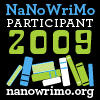I had a great morning yesterday, visiting a class of Writer’s Craft students at a local high school. I talked with them for an hour about publishing: different ways to get your work published, some warnings, some resources and some facts about the money side of the business. The time flew and the class was attentive and asked good questions. I hadn’t visited the school before, but I was made very welcome. I was a bit early and while I waited for the teacher to meet me, without exception every teacher that passed me smiled and said good morning. That doesn’t happen everywhere.
In the co urse of talking about writing resources with the teacher after the class, I mentioned National Novel Writing Month. She teaches a course in the first semester that would overlap NaNoWriMo’s dates, and I thought it might be fun for her students to explore. NaNoWriMo has a fantastic program for young writers with lots of excellent resources for the writers and for teachers who might want to get their classes involved.
urse of talking about writing resources with the teacher after the class, I mentioned National Novel Writing Month. She teaches a course in the first semester that would overlap NaNoWriMo’s dates, and I thought it might be fun for her students to explore. NaNoWriMo has a fantastic program for young writers with lots of excellent resources for the writers and for teachers who might want to get their classes involved.
So this got me to thinking about this coming November. Will I join NaNo and try to write a novel in 30 days? The first time I attempted NaNo, I stopped around 20,000 words. I was happily writing a suspense/romance and enjoying just letting the story go where it may, when I realized that if I could write 20,000+ words in a couple of weeks, why wasn’t I writing the book I had wanted to write for several years? Duh. So, I stopped the novel and finished Writing Fiction: A Hands-On Guide for Teens, instead. My 13-year-old son finished his NaNo novel with 50,000+ words and a lot of pride. The second time, just as we started NaNo, my much-loved mother-in-law began a swift and deadly decline due to pancreatic cancer.
There’s a unique quality about NaNo that seems to crack through something in me that just gets words on the page. Maybe it’s because the objective is so absurd that the writing can’t be overthought or second-guessed, and I don’t put up my usual procrastination roadblocks because I need to post a number every night. Yup. Seeing that graph head upwards really motivates me.
Have you tried NaNoWriMo? What do you think about the experience? Are you thinking of signing up this year? If you’re a teacher, have you ever used the resources or used NaNoWriMo with your class?




 n some days, success is not measured by word count.” That’s where I am at the end of the second week of NaNo. I have written over 19,000 words, but am many short of today’s NaNo word count goal. But the word count I have is so many more than I had two weeks ago, and 6,000 more than I wrote in July when I conscientiously wrote every day for a month. I have been successful in other ways, too. The pile of test papers that I have to mark is diminishing, I worked outside in glorious warm sunshine yesterday, my kitchen is clean, and I watched a mushy movie with my husband last evening while my son wrote up a NaNoWriMo storm and had a blast doing it.
n some days, success is not measured by word count.” That’s where I am at the end of the second week of NaNo. I have written over 19,000 words, but am many short of today’s NaNo word count goal. But the word count I have is so many more than I had two weeks ago, and 6,000 more than I wrote in July when I conscientiously wrote every day for a month. I have been successful in other ways, too. The pile of test papers that I have to mark is diminishing, I worked outside in glorious warm sunshine yesterday, my kitchen is clean, and I watched a mushy movie with my husband last evening while my son wrote up a NaNoWriMo storm and had a blast doing it. The sleeves on a sweater I made this summer were knit on 4 needles. When I finished knitting the second sleeve, I tried the sweater on and the sleeve just didn’t feel right. I had used needles that were a size too small and not noticed. Fed up, I left the sweater in the knitting bag and walked away. I just didn’t feel like unravelling and reknitting the thing after putting all that work into it the first time.
The sleeves on a sweater I made this summer were knit on 4 needles. When I finished knitting the second sleeve, I tried the sweater on and the sleeve just didn’t feel right. I had used needles that were a size too small and not noticed. Fed up, I left the sweater in the knitting bag and walked away. I just didn’t feel like unravelling and reknitting the thing after putting all that work into it the first time.